Aloha, Amazon Seller!
The number of people that shop online tends to increase over the years. Check out the online shopping stats to learn how many people buy online nowadays.
Online shopping is gradually replacing shopping in physical stores. While experts argue whether it’s good or bad, e-commerce customers are increasingly shopping the goods online instead of going to stores, and E-commerce sellers are growing their product sales each fiscal year.
More and more people shop online in the United States as well, and during the past five years US e-commerce trade volumes have almost doubled. The fascinating success story of the e-commerce giant, Amazon.com, proves that.
If you analyze the figures behind the online purchase statistics, they can reveal a lot of tendencies shoppers can use to increase sales. It’s not only interesting to know how many people shop online and online shopping statistics by year. Shopping habits of the buyers change due to the development of technology, and this may influence how you showcase your product listing to drive sales and conversions to it.
In this post, we will talk about the key statistics on online shopping, how many Americans shop online, and how online shopping stats can help sellers.
What Is Online Shopping Statistics?
Online shopping, also referred to as B2C (business-to-consumer), is purchasing and selling of products or services through internet channels. Along with B2B (business-to-business), and C2C (consumer-to-consumer) trade, online shopping is the most popular category of e-commerce.
Statistics on online shopping are data and analytics showing its most important trends. For instance, it describes the reasons for internet shopping growth, which are shopping from home; fast delivery; access to more product information; and personalized shopping experience.
Why Do You Need Online Shopping Statistics?
Analysis of the online shopping stats shows how, what, and in what quantities people buy online. Knowing people’s buying habits and what influences their purchase decision helps improve customer service and drive conversions. Understanding what people buy most helps find your most profitable niche, and knowing the quantities helps forecast expected sales volumes. Also, it is very important to understand the product trending, to monitor the sales dynamics.
How Many People Buy Online?
About three-in-ten U.S. adults say they are ‘almost constantly’ online, and 48% of adults go online “several times a day.” Since shopping is an essential part of human life, no wonder that they prefer to shop online.
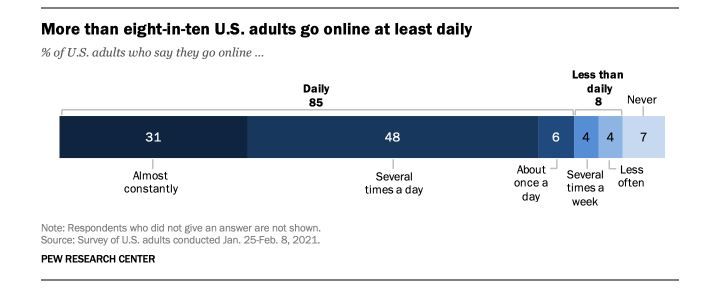
Globally, online sales are expected to reach about $5.5 trillion in 2022. This is up from 4.9 trillion in 2021, and $4.28 trillion in 2020. Future estimates put the total at an impressive $6 trillion in 2024.
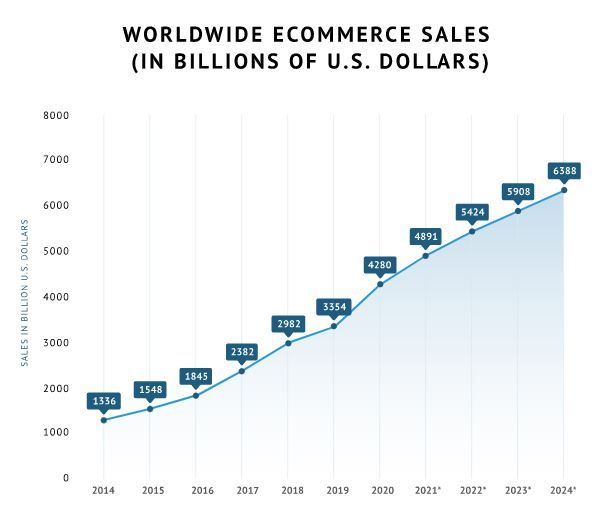
In the United States, e-commerce sales are forecasted to exceed $740 billion by 2023. By 2020, the number of online shoppers reached 256 million, and is expected to reach 263.01 million in 2021, and 278.3 million in 2024.
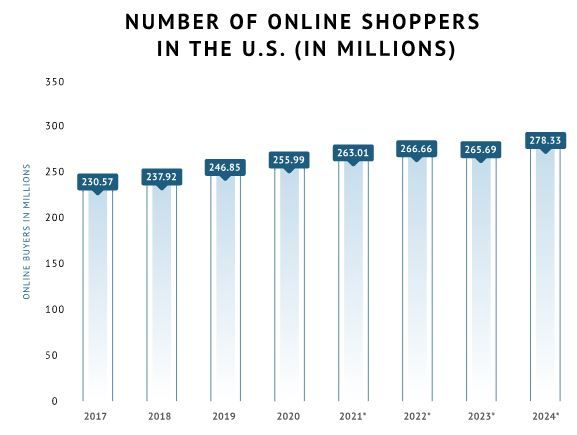
Important Trends of Online Shopping in 2021
2021 has shown that online buyers have increasing expectations for shipping costs and delivery time.
Online Shoppers’ Spending Keeps the Pace
- Overall consumer spending has stayed consistent with spending trends from late 2020;
- 32% of U.S. consumers say their overall spending decreased in early 2021, 43% said it stayed the same, and 26% said it increased.
Online Shopping Is Growing
- 39% say their online spending increased in early 2021 — a 5% increase since late 2020;
- 77% expect their online spending to stay the same.
Amazon Is the Top Marketplace
- 71% of consumers shopped on Amazon in 2021;
- 37% of consumers spent more money on Amazon in early 2021 vs. late 2020.
Walmart steps on Amazon's heels
- 54% of U.S. consumers have shopped in-store at Walmart in 2021, and 39% shopped online at Walmart.com;
- 41% of U.S. consumers are Walmart+ members, up from 38% in Q1.
Price Matters to Shoppers
- When shopping online, 67% of consumers are looking for products with the lowest price;
- 35% of consumers say consistently lower prices than competitors is a top reason why they shop for specific brands;
- 44% of consumers say they often use deal-finding browser extensions or plug-ins like Honey and Pricescout when shopping online.
Shopping Second Hand Is Growing
- 27% of consumers say they are looking for pre-owned products when they shop online;
- 44% of consumers have bought or sold pre-owned items over the last year.
Fast Delivery, Low Shipping Cost
- 51% of U.S. consumers are willing to pay more for a product for faster shipping;
- 56% have noticed changes in online order shipping speed since the beginning of the pandemic;
- 66% of consumers expect free shipping for all online orders, and 91% expect to receive an online order within a week.
7 Important Online Purchasing Stats Takeaways
# 1. Direct to Site, Email, and SEO Generate Most of the Traffic
It is important to know what are your traffic sources, to optimize your advertising strategy accordingly. Stats show, that the best traffic drivers are direct to site, email, and SEO.
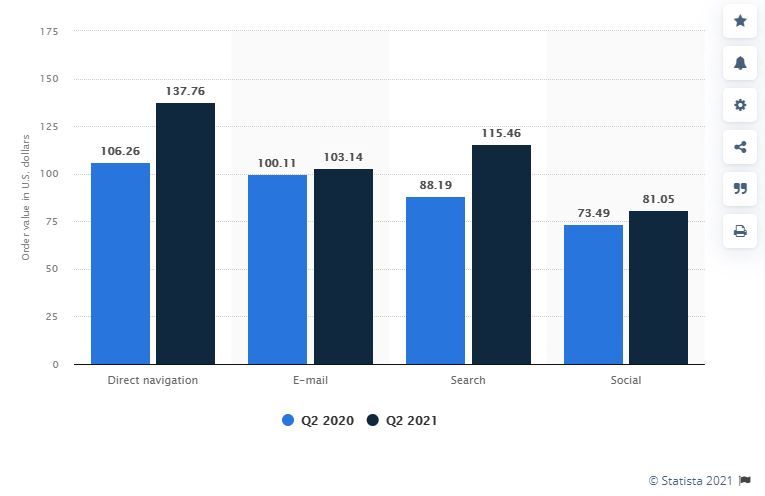
#2. Social Networks Boost Sales
48% of online users aged 18 to 34 are buying goods via social media. As of October 2020, 35% of US adults said that they have been buying through social media (an 8% increase from April 2020). Older shoppers showed lower engagement with the social networks—60% of those 55 and older said that they are not interested in purchasing via social media. At the same time, social networks are extremely important to drive traffic from the youngsters, as they constantly shop online. 48% of adults aged 18 to 34 have purchased through social media, and 11% do so regularly.
31% of US consumers use social media to discover products. The percentage is even higher for younger shoppers—43% of 18 to 24-year-olds and 47% of shoppers 25 to 34. Therefore, it is extremely important to reach these shoppers via Facebook, Instagram, YouTube, and other social media.
#3. Both Desktop and Mobile Sites Are Equally Important
According to Statista, mobile shopping is expected to account for almost 73% of e-commerce. Worldwide, e-commerce growth is first and foremost driven by the shoppers using mobile devices, phones, and tablets. The mobile share of retail e-commerce is as high as 58.9 percent. In 2021, mobile e-commerce is expected to be at the level of 72.9 percent of all e-commerce sales.
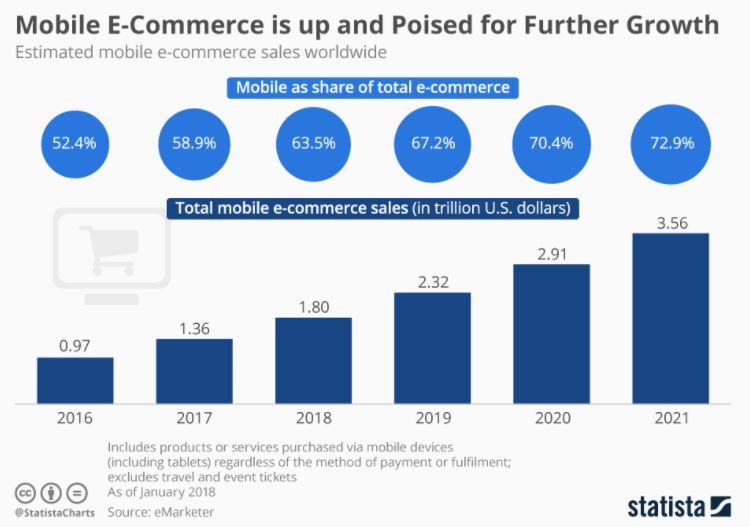
At the same time, around 65% of Amazon buyers prefer to make desktop shopping, They are making their searches and purchases on Amazon’s desktop site, and only 16.6% and 13.6% are using the mobile site and mobile app, respectively.
#4. People Shop Online Via Amazon Searches
The majority (89%) of shoppers are more likely to buy from Amazon than anywhere else. Almost half of the customers visit Amazon’s site several times a week. 89% of shoppers are more likely to make purchases on Amazon than any other E-commerce platform, nearly a quarter of them buy on Amazon every few weeks and 5% shop on Amazon daily or almost every day.
47% of all online shoppers start their searches at Amazon rather than Google. When making their product search online, 47% of online shoppers will go directly to the Amazon website, while 24% of shoppers start their searches in Google. About 14% of buyers make a search in some other places, for example, at a specific online store.
There is a number of reasons why buyers go to Amazon when making online purchases. One of the reasons why the majority of online buyers shop on Amazon is fast, free shipping. 79.8% of online users shop on Amazon because of this. Similarly, 68.9% choose Amazon because of the platform’s broad selection; 65.7% of shoppers opt for Amazon because they are Prime members.
#5. High Shipping Costs Are the Primary Reason for Cart Abandonment
Shopping cart abandonment happens when shoppers add items to their shopping cart but leave before finishing the purchase. Cart abandonment rate is an important business metric that sellers should monitor, as it correlates to customer conversion rates and revenue. A high cart abandonment rate shows that you most likely have a problem with your listing.
A study of U.S. shoppers over the age of 18 has shown, that high shipping costs are the number one reason for cart abandonment for online sales.
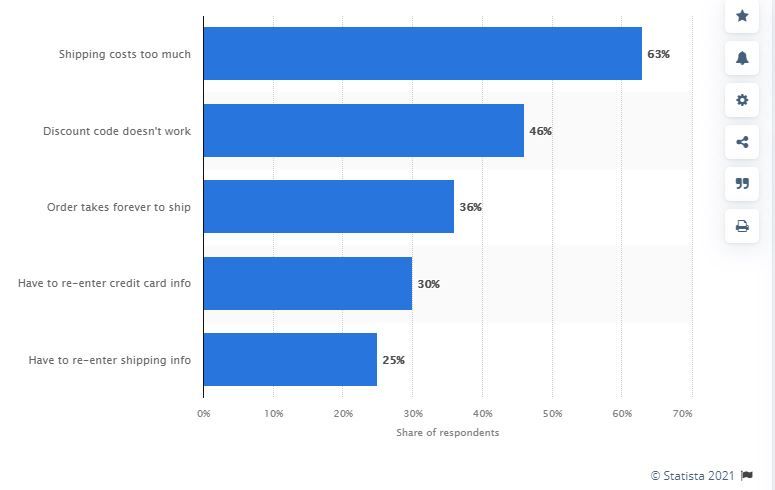
Reasons for the cart abandonment
- Long or confusing checkout process;
- Unexpected shipping costs;
- Mandatory account creation;
- Payment security concerns;
- Restrictions on product quantity;
- Comparison shopping;
- Lack of desirable payment options;
- Unexpected delivery times;
- Site speed and app performance issues;
- No discounts and promo codes to use.
#6. Online Shoppers Purchase a Lot of Entertainment
It is very important to know what shoppers prefer to buy online. The shopping structure by category helps find the new profitable products and outline the trends. According to Statista’s data, books, movies, and games is the product category with the most online purchase preference.
#7. Americans favor PayPal over Any Other Digital Wallet
When it comes to U.S. online payment options, PayPal would be preferred by as many as 89% of Americans. PayPal has made online payments easier and more convenient for shoppers.






